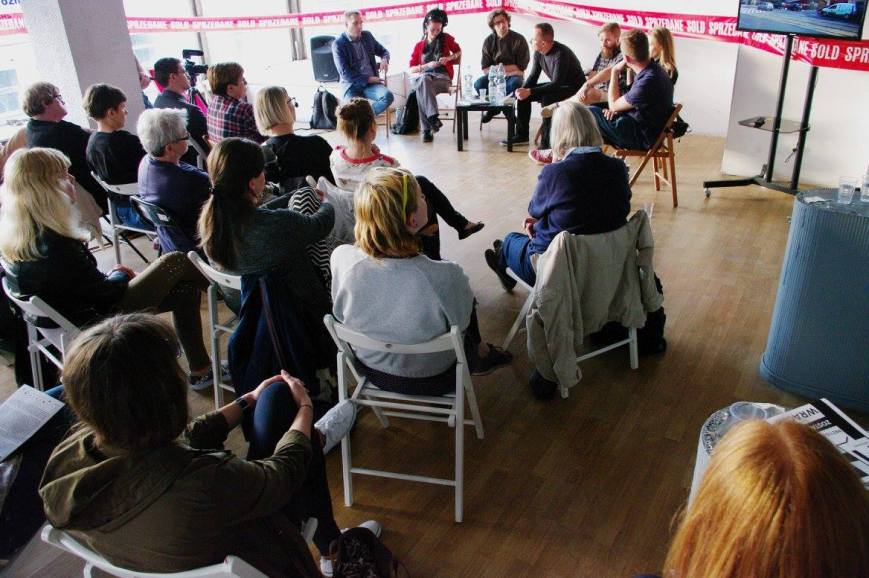Temporary Use can be an efficient tool for municipalities to redevelop abandoned, hard to develop areas and revitalize run down neighbourhoods.
Hlubina, a huge abandoned coal mining and iron production industrial site in Ostrava (Czech Republic), a valuable industrial heritage site right next to the city centre, was standing empty for years while the owner did not see any opportunities for developement. The area was brought back to life with a series of temporary cultural events organized by the NGO “Provoz Hlubina” in 2010.

After the first successes, both the owner and the Ostrava municipality recognized the potential to expand the activities that Temporary Use had brought to the area. The Municipality helped Hlubina to apply for support of the EU Regional operational programme in renovating the area. Currently, the 6 renovated buildings of Provoz host artists’ residences, supports creation of artworks, hosts creative professionals in 17 studios and rents 3 large halls of the complex for events.
Provoz intends to develop more projects such as Art & Crafts Incubator and a beach to complete the requalification of the place into a cultural district. In this way temporary user can trigger for further development, becoming co-developers and transitioning into permanent use.

Lazarz district in Poznan is an area with considerable rates of vacancy and signs of physical degradation. As the regeneration of the city centre, in both social and infrastructural aspects, is one of the priorities for the Poznan, the municipality decided to start cooperating with neighborhood initiative group “Open Zone for Culture”, which is seeking to foster creative use of vacant space, renew neglected space and create accessible culture.
One emblematic example of this cooperation is Perfex, an abandoned cafe, municipal property, which used to be one of the hearts of Lazarz district and now, with the help of a Temporary Use agreement, has been turned into informal cultural centre organizing performance, exhibition, concerts, open computer festival, coffee place aiming at mixed audience including local population and amateurs of culture and art. The initiators of Perfex have not only opened access to space, but also renovated it performing service of “soft maintenance”.

In general, the cooperation with “Open Zone for Culture” has resulted in more art and cultural initiatives able to offer workshops, courses, artistic activities for all ages from kids to adults or seniors. It has generated a positive social atmosphere in the neighbourhood: “our Kreuzberg” says Marcin Kostaszuk, director of the Department of Culture. From the example of Ostrava and Poznan, cultural NGOs can be clearly profiled as facilitators of revitalization of degraded areas that municipality should partner with.
Temporary use can serve as a tool to revitalize inactive commercial and shopping areas. In Athens, the municipality called on temporary users to revitalize so-called “Gallery of Merchants”, a vacant shopping passage in the city centre of Athens. For the past few years its shops were closed and the arcade was abandoned as a direct consequence of the crisis.

As part of project “Traces of Commerce”, the municipality acted as a broker between owners and initiatives. In order to occupy shops, users had to organize events (open to the public) as a form paying back the rent. A fab lab, a hat designer, fanzine editors, graphic designers and others were hosted for periods of 8 months in the vacant shops, showcasing their activities, and organizing workshops, speed-dating, concerts and talks, open to the public, which attracted many visitors. The owners of the nearby shops, cafes and bars also claimed that they were affected as well in a very positive way.
Similarly, the ‘Brabantdam’ shopping street in Ghent had a hard time because of continuous (road) works. With the project TRAVAK, it was transformed into a temporary shop-up zone full of creative or artisan pop-up projects. Photographers, furniture designers, screen printers, instrument builders… were reviving the empty shop windows. An exhibition container was filled by some famous graphic artists and photographers, amongst others. An old reconverted tram, the ‘Brabant-tram’, was available for some months for the organization of audiovisual events. These activities revived the empty shop windows and drew considerable attention and foot traffic to the street.

This article is part of the series “Providing Temporary Use services” in which Mārcis Rubenis from Free Riga and Irīna Miķelsone from the City of Riga (Latvia) are describing some examples of how Temporary Use initiatives can see and market themselves as a form of service.

